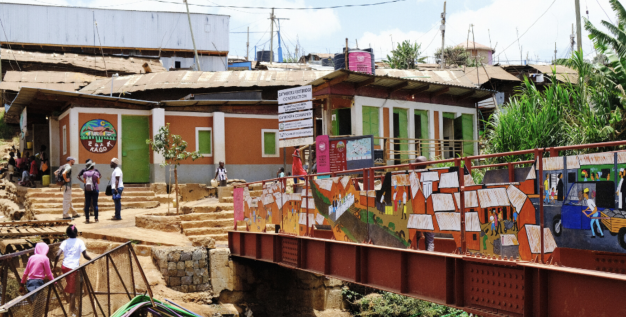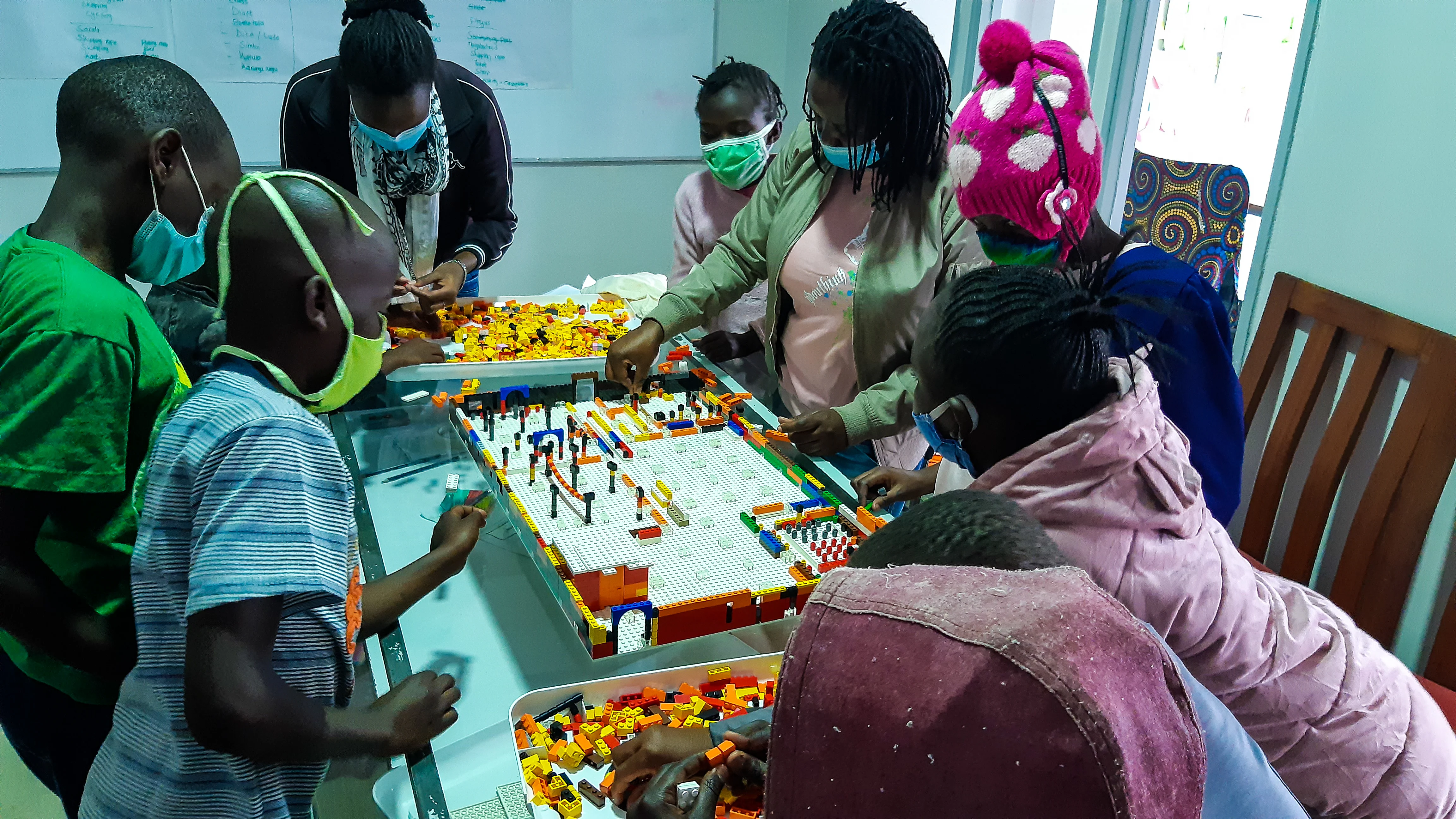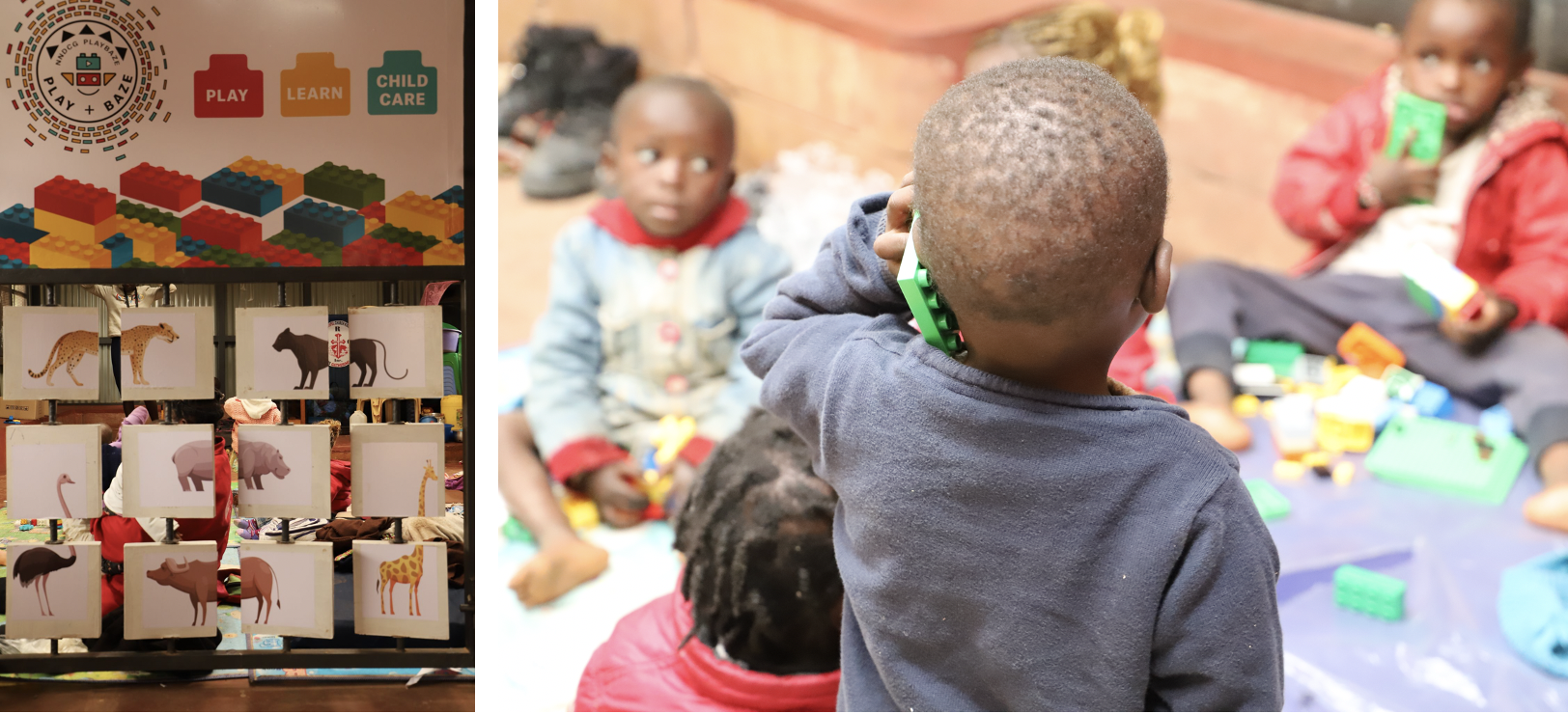
Putting local communities at the center of public space making in informal settlements
The Kounkuey Design Initiative (KDI) collaborates with local community groups to transform underutilized risk-prone spaces in Kibera into a resilient and productive network of public spaces. This network of public spaces – comprising toilets, multipurpose halls, micro-enterprises, laundry facilities, play spaces, vegetable gardens, and schools – builds physical, social and economic resilience in informal communities providing multiple benefits for all members of the community, including children and youth.
Kibera Public Space Project (KPSP)
KDI is a not-for-profit design and community development organization active in Kibera and Mukuru, two large informal settlements in Nairobi, since 2006. The organization collaborates with community-based groups to co-create public spaces that support everyday needs related to sanitation, childcare, play and recreation, mobility, socializing, safety, income generation and food security.
This initiative, also known as the Kibera Public Space Project (KPSP) is ongoing and consists of 11 unique public spaces. Each public space was developed with multiple stakeholders, such as community-based organizations, residents, experts, local governments, universities, and local and international organizations.
An example of public space in KPSP
Of the eleven public space projects, some include transforming busy, polluted areas along the flood-prone riverside into safe and productive spaces. One especially stands out. The fourth public space KPSP04 was developed in partnership with three community groups: Slumcare, The New Ndovu Women Group and Usalama Bridge Youth Reform group. Here KDI transformed a flood-prone and polluted space along a frequently used settlement route into a safe and resilient public space comprising a childcare collective, common sanitation facilities, a pedestrian bridge and a play space. Retaining walls protect the space from floods, and local children use the space for play, learning and other activities. The youth group have an office space from which they operate a local taxi service, while the women’s group operates the childcare collective.

The fourth public space KPSP04 before and after the transformation © Konkuey Design Initiative
Co-creating productive public spaces with children and youth
Local wisdom, partnership and ownership are seen as vital for co-creating and co-developing public spaces. Their model of practice follows the pattern ‘ask, listen, collaborate, and repeat’ to intimately understand the needs of local communities and ensure these are integral to processes and solutions.
In each project, community members, including children and youth, are consulted in needs assessment, co-design and building phases. Methods such as drawing, modeling, and ‘Building with Bricks’ similar to Legos are employed to involve children and to understand their needs, priorities and ideas for change. They then incorporate these ideas into public space solutions. In some projects, local youth have been trained in skills to build the public space infrastructure, and children have been encouraged to use their creative skills to make public spaces livelier through art and play.

Children using bricks, similar to Legos, to communicate their ideas for a public space project © Konkuey Design Initiative
Three ways public spaces benefit children, youth and caregivers
1. Spaces for safe play and learning
Nearly all the public space projects include play spaces for children alongside other vital community facilities such as sanitation blocks, childcare, schools, micro-enterprises, and laundry facilities. This co-location of facilities allows caregivers to keep an eye on children while doing other things and providing children with safe spaces for play and learning. Two public spaces have childcare facilities providing much-needed safe and nurturing community-based childcare. A partnership with Nexon Foundation helped develop and install Playbazes in childcare facilities. Playbazes are play stations with various toys and games supporting children’s play and learning activities.
There is also a mobile version, a play cart which serves as a pop-up play space in underserved neighbourhoods for a few hours every week. Additionally, community members and childcare staff are trained to facilitate play sessions. The organisation has also partnered with Arup and the Bernard van Leer Foundation to pilot the Proximity of Care Design Guide in the Makina Village, Kibera, and develop public space solutions that work for young children and caregivers.

A playbaze installation in a childcare collective and children playing with blocks in a playbaze © Konkuey Design Initiative
2. Supporting youth employment
Local youth have been involved in constructing some of these facilities. They are actively supported to increase their skills along with their employability and potential to earn income via partnerships with local and international organizations. For example, the KDI-KEFRI Carpentry Training Academy trains youth in constructing bamboo and timber furniture and fixtures. Trained youth were employed in developing two public spaces in the network- KPSP08 and KPSP11. As a result of the training, they could produce vibrant new furniture and fittings to renovate a dilapidated local primary school. In three other public spaces, local youth have been able to set up small businesses. In KPSP01, they grow and sell fruits and vegetables; in KPSP04, they operate a local taxi service; and in KPSP11, they manage the public sanitation block, providing water and sanitation services.
3. Climate education and anticipatory action
Kibera is situated adjacent to the Ngong River. Increasingly heavy rains related to climate change, unchecked development, poorly managed waste, and loss of permeable surfaces put the settlement at severe risk of flooding. Improving flood resilience in the settlement has been initiated through consultation with local community members to understand better how seasonal floods affect their health, security and livelihoods. A flood-alert communication system was put in place and community members have been trained on how to use it. Locally relevant flood resilient infrastructure has also been tested, developed and implemented. To further sustain these efforts and build local capacities, skills and knowledge have been transferred to local communities, government, and other organizations working in Kibera.
Enabling sustainability in an environment of risk and insecurity
Kibera, like other informal settlements in Nairobi, faces multiple challenges, including lack of secure housing, deficiencies in infrastructure, increased risks due to climate change, poverty and violence, all issues that could easily undermine the KPSP network. In order to ensure the sustainability of the projects here and elsewhere, KDI has:
- Signed MOUs with local community groups and municipalities to establish co-design, building, maintenance and ownership practices.
- Built capacities of community groups around accounting, management, building and repair.
- Built awareness and advocated for the importance of inclusive and resilient public space among local communities and governments. This was done via events such as local festivals, fairs, and government forums.
- Used local materials and skills to implement projects to support local incomes and ensure easy maintenance and repair.
- Developed toolkits and shared knowledge to support other informal communities and organizations incorporate nature-based resilient infrastructure and solutions in upgrading efforts.
- Incorporated social and economic resilience via supporting income-generating activities in public spaces. A share of these dividends is channelled towards the maintenance and upkeep of public spaces.
- Set up conflict management systems to ensure the smooth functioning of public spaces.
The KPSP is an inspiring example of how built-environment professionals, city authorities and community-based groups and organizations can enable and support more child, youth and caregiver-friendly environments in informal settlements, which are also climate resilient.
Blog based on a conversation with Gloria Tanui, Kezia Ojal, Prisca Okila and Annelyn Oranga who work in KDI’s community engagement and design departments. This blog was first published by the Global Alliance – Cities4Children (www.cities4children.org/blog)




